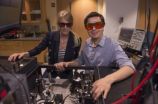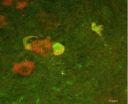Pistachios may lower vascular response to stress in type 2 diabetes
2014-08-05
(Press-News.org) Among people with type 2 diabetes, eating pistachios may reduce the body's response to the stresses of everyday life, according to Penn State researchers.
"In adults with diabetes, two servings of pistachios per day lowered vascular constriction during stress and improved neural control of the heart," said Sheila G. West, professor of biobehavioral health and nutritional sciences. "Although nuts are high in fat, they contain good fats, fiber, potassium and antioxidants. Given the high risk of heart disease in people with diabetes, nuts are an important component of a heart healthy diet in this population."
West and her colleagues investigated the effects of pistachios on responses to standardized stress tasks in patients with well-controlled Type 2 diabetes who were otherwise healthy. They used a randomized, crossover study design in which all meals were provided. Each of the diets contained the same number of calories.
After two weeks on the typical American diet -- containing 36 percent fat and 12 percent saturated fats -- participants were randomized to one of two test diets. During the four-week test diets, participants ate only food supplied by the study. The researchers reported the results of this study in a recent issue of the Journal of the American Heart Association.
Test diets included a standard heart-healthy diet -- 27 percent fat and 7 percent saturated fat -- and a diet containing two servings per day of pistachios -- about 3 ounces or 20 percent of calories from pistachio nuts. The typical research participant consumed about 150 pistachio nuts per day. The pistachio diet contained 33 percent fat and 7 percent saturated fat. Half of the nuts consumed each day were salted and half were unsalted. At the end of each four-week diet period, the researchers measured blood pressure and total peripheral vascular resistance at rest and during two stress tests -- a cold water challenge and a confusing mental arithmetic test.
"After the pistachio diet, blood vessels remained more relaxed and open during the stress tests," West said.
Although laboratory measurements of blood pressure were not affected by pistachios, real-world measures of blood pressure (measured by an automated monitor) were significantly lower after the pistachio diet. Katherine A. Sauder, former graduate student in biobehavioral health, conducted these measurements.
"We found that systolic blood pressure during sleep was particularly affected by pistachios," she said. "Average sleep blood pressure was reduced by about 4 points and this would be expected to lower workload on the heart."
The researchers found that the pistachio diet lowered vascular constriction during stress. When arteries are dilated, the load on the heart is reduced. The physical challenge involved immersing one hand into icy water for two minutes.
"This cold stressor produces a large vascular constriction response in most people," said West. "In comparison with a low fat diet, the pistachio diet blunted that vascular response to stress."
The same pattern was seen when participants engaged in a challenging and confusing mental arithmetic task.
"Our participants still felt frustrated and angry during the math test," West noted. "The pistachio diet reduced their bodies' responses to stress, but nuts are not a cure for the emotional distress that we feel in our daily lives."
Sauder added: "As in our last study of pistachios, we did not see lower blood pressure in the laboratory setting with this dose of nuts. However, we were surprised and pleased to see that 24-hour ambulatory blood pressure was lower after the pistachio diet."
The researchers also recorded improvements in heart rate variability, a measure of how well the nervous system controls heart function. These data indicate that pistachios increased the activity of the vagus nerve, an important part of the parasympathetic nervous system that can be damaged with diabetes.
"If sustained with longer term treatment, these improvements in sleep blood pressure, vascular response to stress and vagal control of the heart could reduce risk of heart disease in this high risk group," West said.
INFORMATION:
Other researchers on this study included Cindy E. McCrea, graduate student in biobehavioral health; Jan S. Ulbrecht, endocrinologist and professor of biobehavioral health and medicine; and Penny M. Kris-Etherton, Distinguished Professor of Nutritional Sciences.
The American Pistachio Growers, formerly the Western Pistachio Association, supported this study. Partial support also came from the NIH-supported Clinical Research Center at Penn State.
ELSE PRESS RELEASES FROM THIS DATE:
Watching chemistry in motion: Chemical environments mapped using molecular vibrations
2014-08-05
Scientists have long known that a molecule's behavior depends on its environment. Taking advantage of this phenomenon, a group of researchers at the University of Chicago developed a new technique to map microscopic environments using the vibrations of molecules.
"It's a special new advance that will be broadly useful in studies of molecular and materials phenomena," said Andrei Tokmakoff, the Henry G. Gale Distinguished Service Professor in Chemistry at UChicago. He and two of his associates report their new technique in a paper published online in the journal Optics ...
Physicists eye neural fly data, find formula for Zipf's law
2014-08-05
Physicists have identified a mechanism that may help explain Zipf's law – a unique pattern of behavior found in disparate systems, including complex biological ones. The journal Physical Review Letters is publishing their mathematical models, which demonstrate how Zipf's law naturally arises when a sufficient number of units react to a hidden variable in a system.
"We've discovered a method that produces Zipf's law without fine-tuning and with very few assumptions," says Ilya Nemenman, a biophysicist at Emory University and one of the authors of the research.
The ...
'Treatments waiting to be discovered' inside new database
2014-08-05
Your genes are blueprints for proteins, and molecules called microRNA can help to determine how often these genetic blueprints are manufactured into proteins. Researchers often ask what microRNA regulates a gene related to disease. Or what gene is regulated by a microRNA found in sick patients? The answers to these questions could help doctors and researchers manipulate protein levels in the body that cause disease, especially cancer. A University of Colorado Cancer Center study recently published in the top-ranked journal Nucleic Acids Research (NAR) describes a database ...
Monthly preventative treatment with a new drug combination reduces malaria in children
2014-08-05
Preventative treatment with a monthly dose of a newer antimalarial drug can reduce the risk of malarial infection among young children, according to a study published in this week's PLOS Medicine. The study, conducted by Victor Bigira and colleagues at San Francisco General Hospital and the Makerere University College of Health Sciences in Kampala, Uganda, finds that treating young children with dihydroartemisinin-piperaquine (DP) decreased their risk of contracting malaria.
Preventative treatment of malaria is a useful strategy to protect young children in Africa, but ...
Pregnant women are often given inappropriate treatment for malaria
2014-08-05
Not all pregnant women with symptoms of malaria seek care from their formal healthcare system and if they do seek care, they may be given inappropriate treatment because healthcare providers often fail to adhere to the standard (World Health Organization-WHO) diagnostic and treatment guidelines, according to a study by UK researchers published in this week's PLOS Medicine.
The authors (led by Jenny Hill from the Liverpool School of Tropical Medicine) reached these conclusions by reviewing all relevant studies that investigated the factors that affect pregnant women's ...
A campaign involving Muslim clerics has increased uptake of polio vaccination in Nigeria
2014-08-05
A coalition campaign involving imams, Islamic school teachers, traditional rulers, doctors, journalists, and polio survivors is gradually turning the tide against polio vaccine rejection in northern Nigeria, according to experts from Nigeria writing in this week's PLOS Medicine.
Sani-Gwarzo Nasir (from the Federal Ministry of Health in Nigeria) and colleagues describe how anti-polio propaganda, misconceptions, and violence against vaccinators present huge challenges to polio eradication in Nigeria but perhaps most profound is the rejection of vaccination by Muslim clerics.
However, ...
Just one simple question can identify narcissistic people
2014-08-05
COLUMBUS, Ohio – Scientists have developed and validated a new method to identify which people are narcissistic: just ask them.
In a series of 11 experiments involving more than 2,200 people of all ages, the researchers found they could reliably identify narcissistic people by asking them this exact question (including the note):
To what extent do you agree with this statement: "I am a narcissist." (Note: The word "narcissist" means egotistical, self-focused, and vain.)
Participants rated themselves on a scale of 1 (not very true of me) to 7 (very true of me).
(How ...
Salk scientists uncover new clues to repairing an injured spinal cord
2014-08-05
LA JOLLA—Frogs, dogs, whales, snails can all do it, but humans and primates can't. Regrow nerves after an injury, that is—while many animals have this ability, humans don't. But new research from the Salk Institute suggests that a small molecule may be able to convince damaged nerves to grow and effectively rewire circuits. Such a feat could eventually lead to therapies for the thousands of Americans with severe spinal cord injuries and paralysis.
"This research implies that we might be able to mimic neuronal repair processes that occur naturally in lower animals, which ...
Year-round preventive treatment reduces malaria risk in young children
2014-08-05
A year-round preventive drug treatment substantially reduces young children's risk of contracting malaria and poses no serious risk of adverse events, according to a study by researchers funded by the National Institutes of Health.
The findings demonstrate that prolonged treatment given from 6 to 24 months of age is safe and effective for young children, according to the study authors. Year-round preventive measures are badly needed in locations like Uganda, where the study took place, and where malaria rates remain high throughout the year.
Most previous studies using ...
How spiders spin silk
2014-08-05
Spider silk is an impressive material; lightweight and stretchy yet stronger than steel. But the challenge that spiders face to produce this substance is even more formidable. Silk proteins, called spidroins, must convert from a soluble form to solid fibers at ambient temperatures, with water as a solvent, and at high speed. How do spiders achieve this astounding feat? In new research publishing in the open access journal PLOS Biology on August 5, Anna Rising and Jan Johansson show how the silk formation process is regulated. The work was done at the Swedish University ...

